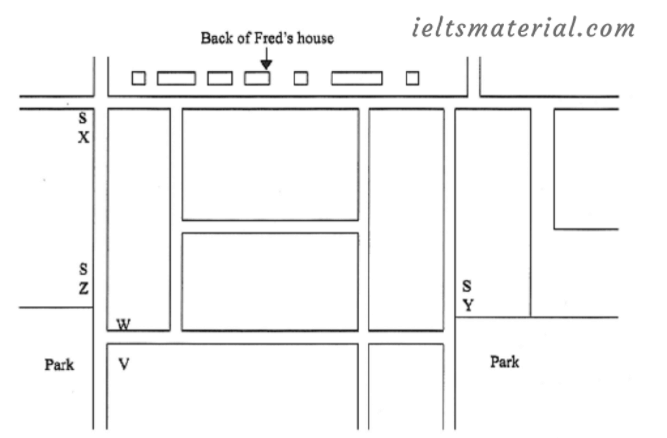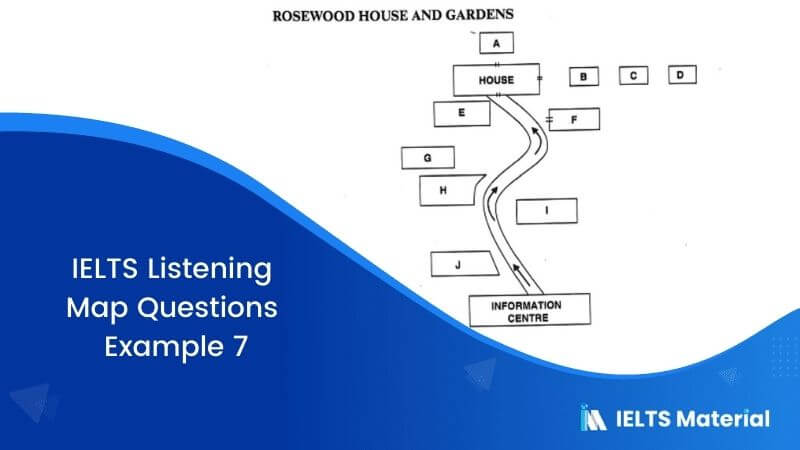IELTS Listening Map Completion Questions
Map Completion questions mostly include the floor map of a building or a place. Master these IELTS Listening map completion questions with tips, IELTS map vocabulary, and sample tests.
Table of Contents
- Understanding IELTS Map Completion Questions
- Strategies for Answering the IELTS Listening Map Diagram Questions
- IELTS Listening Map Vocabulary
- Tips to Solve IELTS Listening Map Completion Questions
- Common Challenges with IELTS Listening Map Completion Questions
- IELTS Listening Map Practice with Answers

Limited-Time Offer : Access a FREE 10-Day IELTS Study Plan!
Map Labelling questions are quite common in the IELTS Listening exam and can be tricky since they ask applicants to identify places or items on a map while following an audio description. It aims to test your ability to connect information in the audio with the given map and fill in the gaps with the correct information.
Here, we will learn some pointers about IELTS Listening map completion questions, discuss some strategies and IELTS Listening map vocabulary, and take up some listening map practice tests to improve the listening skills.
Understanding IELTS Map Completion Questions
Map completion questions in the IELTS Listening actual tests are visual representation based on which you have to answer some questions with information from the audio.
-
You will hear a monologue related to a map related to building floor plans (e.g., museum layout), campus maps or public places (e.g., parks, event venues, or streets). Sometimes, in the IELTS Listening map labelling questions, the speaker may mention suggested modifications to a specific area.
-
Many IELTS candidates consider this question type as the easiest to respond to because the image usually includes plenty of clues regarding the missing words, especially in the labels that are already present.
-
Sometimes, you are provided with a list of words, and you have to choose the correct name to fit in the map. Other times, there are no words, and you would have to listen to the audio keenly and answer the questions.
-
They mostly come in the second part of the test. However, there is no strict rule.
-
The information that you will have to answer the question will come in the same order as in the recording and the question sheet.
Example of IELTS Listening Map Completion Question
On the map below, choose the letter representing the liquor store. Note: S means ‘supermarket’. Listen to the audio.

Here, you can see the map of an area where one friend, Fred, is guiding another friend, Mary, to a liquor store to bring enough liquor to the farewell party. You have to follow the direction in the audio and find out which letter represents the liquor store.
Strategies for Answering the IELTS Listening Map Diagram Questions
Here are some effective strategies on how to ace IELTS Listening map completion questions using the above map diagram as an example:
- Read the Instructions - It is the first most important step to take while solving map completion questions as this kind of question varies in both language and what you must find out. Also, hints (S means ‘supermarket’) and word count are given there that come in handy and you have to follow them strictly.
- Study the Map Carefully - Before the recording begins, take a few seconds to scan the map. Look for marked landmarks like entrances, exits, and distinctive features, like ‘Back of Fred’s house’, ‘Park’ as given on the above map. These will often serve as starting points or reference locations. Also, pay attention to the numbered or lettered locations (S, X, W, V, Y), as these represent places you will need to identify during the listening.
- Pay Attention to the Sequence in the Audio - The audio usually describes locations in sequence, guiding you step by step. Stay focused on marking each location as it's mentioned. For example, in this audio, you will hear Mary asking for the direction to the ‘nearest liquor store’, followed by Fred’s instructions of ‘Go out the front door, turn right. Sorry left. Take the second street on your right …’. In case you miss one, let it go and stay with the audio to avoid falling behind. After marking a location, look briefly at nearby points on the map. This way, you’ll be ready to locate the next area quickly.
- Visualize the Directions in the Audio - Your task will become easier when you visualize the directions the speaker is given and follow the map. For example, when Fred says, “Go out the front door…”, pretend that you are just opposite of the place marked ‘Back of Fred’s house’. You have to be careful of the minor differences in the instructions like ‘front door’ and ‘back of the house’ or you will get confused. Moreover, understand that the ‘left’ and ‘right’ on the map here is the opposite of your left and right since you are facing the front door.
- Look out for Distractors - Speakers often correct themselves or add new details after the initial instruction. These are IELTS Listening distractors and might cause confusion and lead to mistakes. For example, in this audio, Fred says, “Not far. Go out the front door, turn right. Sorry left.”. Here, ‘turn right’ is the distractor since it is incorrect information. So, stay attentive and don’t mark an answer until you’re sure it’s correct.
- Use Process of Elimination - If a location is unlikely based on prior directions, eliminate it as a possible answer. For example, the audio says ‘Take the second street on your right’ and eliminate all areas that are clearly not in that direction. Keep following the directions as Fred says it to reach your destination, which is ‘Y’.
- Answer Order is the same as Audio - Remember that when there is more than one place to label or gaps to complete in the map completion questions, the answers in the audio will be in the same sequence that they appear in the question. This makes it easier to find out and saves time.
IELTS Listening Map Vocabulary
Before you begin answering the Map completion question, it is important to pay attention to the IELTS vocabulary related to maps, which might give you an idea of the location of the room. Here is a simple list of words that you will need to solve IELTS Listening map completion questions.
- At the top / at the bottom
- On the left / on the right
- Left-hand side / right-hand side
- South / North / East / West
- Southeast / Southwest / Northeast / Northwest
- To the north / the south / the east / to the west
- Opposite / in front of / behind
- In the middle / in the centre
- Near / Beside / Between
- In front of / Across
- Above / below
- Inside / outside
- Just beyond / a little beyond / just past
- Next to / alongside / adjoining (= next to or joined with)
For more listening map vocabulary and information on map completion questions, check out the video below!
Tips to Solve IELTS Listening Map Completion Questions
Some IELTS Listening tips to answer the questions and obtain a high band in the IELTS examination are given below:
- Read all the instructions carefully and try predicting answers in IELTS Listening before you hear the recording. The word that you would have to answer could be an adverb, a verb, an adjective, a direction, a building or a location. Try predicting the word type beforehand.
- Try visualizing the scenario by putting yourself in the position of the audience with whom the speaker is conversing.
- Ensure that you listen to the beginning carefully, as it will help you understand the topic.
- Take notes whenever possible so that you don’t forget anything.
- Practise understanding phrases such as ‘turn left’, ‘next to,’ ‘on your right’ ‘across from’, ‘straight ahead’, and others. These common words in IELTS Listening related to direction will help you follow instructions smoothly.
- Practise various map types (e.g., parks, shopping malls, universities) to build familiarity with common layouts. Additionally, listen to audio that includes directional language, like podcasts or audio tours, to improve your ability to process spatial instructions.
- You don’t need to write complete sentences. Short labels, such as ‘Café’ or ‘Playground’, or use the letters ‘X’, ‘Y’ as instructed on the given map. This will save time.
Common Challenges with IELTS Listening Map Completion Questions
While practising the map labelling questions, you might face unique challenges like the ones given below. Being aware of them is essential to be prepared for them and score a high IELTS band score.
- Understanding Directions: You will often hear complex directional language like ‘to the right’, ‘next to’, ‘opposite’, and ‘across from’.
- Listening and Marking Simultaneously: You must listen carefully while marking locations, requiring quick comprehension.
- Identifying Clues in the Audio: You need to pay attention to every detail, as small directional cues can be crucial for the correct answer.
IELTS Listening Map Practice with Answers
Take the two IELTS Listening practice tests given below and get an idea of the areas to improve for a better score in this section.
Test 1
Look at the map of the Sports Complex below.
Label the buildings on the map of the Sports Complex.
Choose your answers from the below list and write them against questions 17-20.
Listen to the audio and answer the questions.
- Arts studio
- Football pitch
- Tennis courts
- Dance studio
- Fitness room
- Reception area
- Squash courts
17.........................
18 .........................
19 .........................
20 .........................
Test 2
Listen to this audio and write the correct letter A-H, next to questions 16-20.
16 Box office .........................
17 Children’s room .........................
18 Café .........................
19 Multimedia room .........................
20 Showroom .........................
Answer Key
| Test 1 | Test 2 |
|---|---|
|
17 Reception area 18 Dance studio 19 Squash courts 20 Fitness room |
16 C 17 B 18 E 19 H 20 G |
Here are the 10 examples for the IELTS Listening Map Completion:
- Example 1
- Example 2
- Example 3
- Example 4
- Example 5
- Example 6
- Example 7
- Example 8
- Example 9
- Example 10
To conclude, IELTS Listening map completion questions can be mastered with consistent practice. By improving your ability to interpret spatial language and follow directions, you will enhance your chances of scoring well on these questions and improving your IELTS band score.
Also Check:
Frequently Asked Questions
Can I make notes in the map question?
What is the aim of the map question?
What is the maximum number of words to be written in the map?

Start Preparing for IELTS: Get Your 10-Day Study Plan Today!
Explore other Map Completion Questions

Prity Mallick

Prity Mallick

Prity Mallick

Prity Mallick
Recent Articles

Kasturika Samanta

Prity Mallick

Haniya Yashfeen

Kasturika Samanta




Post your Comments